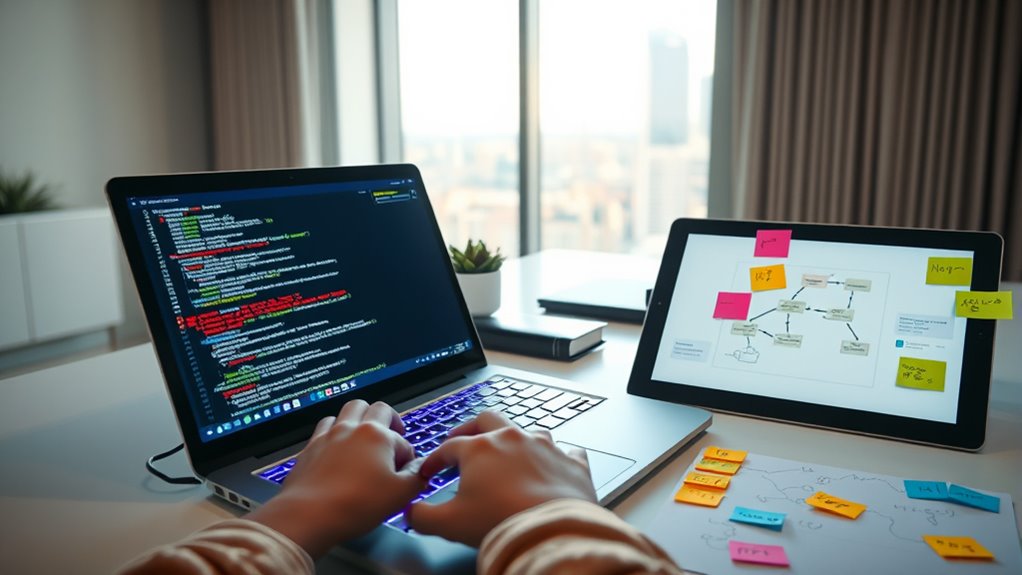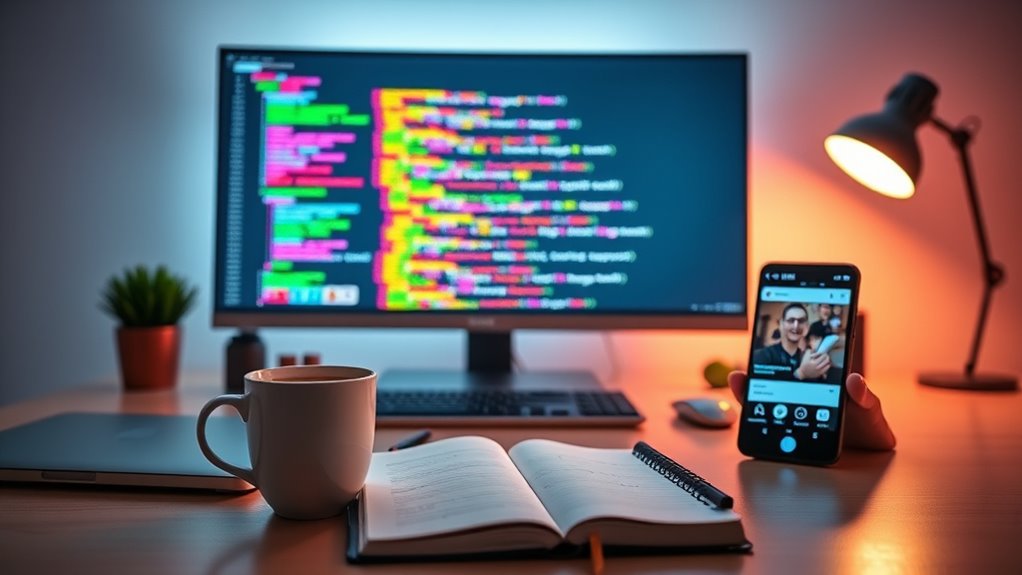To use AI to write your first program, start by choosing beginner-friendly AI coding tools or platforms that offer code suggestions, auto-completion, and debugging features. You can input simple problem statements or descriptions, and the AI will generate relevant code snippets, guiding you through the process. These tools help reduce errors and boost confidence, making coding easier. If you keep exploring, you’ll discover even more ways to harness AI for your programming journey.
Key Takeaways
- Use beginner-friendly AI coding platforms to input your problem statement and generate initial code snippets.
- Leverage AI tools with auto-completion and debugging features to learn correct syntax and fix errors.
- Start with simple programs like “Hello World” to familiarize yourself with AI-assisted coding processes.
- Utilize tutorials and explanations provided by AI tools to understand the logic behind generated code.
- Experiment and iterate by modifying AI-generated code to deepen your understanding and build confidence.

Have you ever wondered how artificial intelligence can help you write your first program? If you’re new to coding, it might seem intimidating, but AI integration can make the process smoother and more approachable. To get started, understanding some coding basics is essential. You don’t need to become an expert overnight; instead, focus on grasping fundamental concepts like variables, loops, and functions. These building blocks form the foundation of almost every program and will serve you well as you explore AI tools designed to assist coding.
AI can help beginners grasp coding basics like variables, loops, and functions, making programming more approachable.
When you begin working with AI to write your first program, you’ll find that many platforms and tools are built with user-friendliness in mind. These tools often include code generators, auto-completion features, and debugging assistants that leverage AI integration. For example, you can input a problem statement or a description of what you want your program to do, and the AI can suggest code snippets that match your needs. This not only saves you time but also helps you learn by seeing real examples of how specific coding tasks are accomplished.
Using AI to support your coding journey allows you to focus more on problem-solving and logic rather than getting stuck on syntax errors or minor bugs. As you type, AI-powered IDEs (integrated development environments) can predict your next move, correct mistakes, and offer improvements. This continuous feedback loop accelerates your learning curve and builds confidence. Moreover, many AI tools are equipped with tutorials and explanations, so you can understand why certain code works the way it does, reinforcing your grasp of coding basics. Additionally, understanding how programming languages work can help you better utilize AI tools effectively in your projects.
Another advantage of AI integration is that it democratizes programming. You don’t need a computer science degree to start coding; AI tools can guide you through the process step by step. As you experiment with different code snippets, you’ll start recognizing patterns and understanding how different components fit together to form a functioning program. Furthermore, incorporating wall organization and visual aids can help you better understand complex code structures and keep your workspace tidy during development. Recognizing the importance of resources and tools from different regions can also help you identify the most suitable AI platforms for your needs. Additionally, being aware of local store hours and their impact can be useful if you plan to purchase hardware or attend in-person coding workshops to enhance your learning. Embracing modern development practices and tools will further streamline your learning process and improve your coding efficiency over time. Over time, this hands-on approach helps you develop your skills and deepen your understanding of coding basics.
Frequently Asked Questions
Can AI Replace Human Programmers Entirely?
AI can’t replace human programmers entirely because AI ethics and programmer creativity are crucial. While AI can automate coding tasks, it lacks the intuition, problem-solving skills, and ethical judgment humans bring. You’ll find AI as a powerful tool to enhance your work, not replace your creativity or ethical decision-making. Your role remains essential in designing, refining, and overseeing AI-generated code, ensuring it aligns with human values and innovative goals.
What Programming Languages Are Best for Beginners Using AI?
You should start with beginner-friendly languages like Python or JavaScript, as they support various programming paradigms and make learning easier. These languages help you grasp core concepts like code optimization while using AI tools to generate and refine code. By choosing approachable languages, you can experiment with different paradigms and improve your skills faster, making your programming journey smoother and more enjoyable.
How Secure Is Ai-Generated Code From Vulnerabilities?
AI code security depends on how well it’s designed and reviewed. While AI can help identify vulnerabilities and suggest mitigation strategies, it’s not foolproof. You should always verify AI-generated code for potential vulnerabilities and apply best practices for vulnerability mitigation. Remember, AI tools are aids, not replacements for thorough testing and security checks, so stay vigilant to ensure your code remains secure from exploits.
Do I Need Prior Coding Experience to Use AI Tools?
You don’t need prior coding experience to use AI tools effectively. These tools can help you learn fundamentals and build your coding confidence, even if you’re a beginner. AI provides guidance, suggestions, and simplifies complex tasks, making programming more accessible. As you practice, you’ll develop skills and understanding, gradually becoming more comfortable with coding. AI acts as a supportive partner to help you start your programming journey with ease.
How Do I Troubleshoot Errors in Ai-Generated Programs?
When troubleshooting errors in AI-generated programs, you need to focus on code debugging and error analysis. Start by carefully reviewing the error messages, then isolate the problematic code sections. Use debugging tools to trace the logic, and test small changes to identify issues. Document your findings, research unfamiliar errors, and adjust your code accordingly. Consistent analysis and debugging help you resolve problems efficiently and improve your programming skills.
Conclusion
Just like planting a seed and watching it sprout, your first program with AI is the start of something incredible. I remember my first code—confusing at first, but with AI’s help, I transformed uncertainty into confidence. Think of AI as your guiding compass in this journey; with patience and curiosity, you’ll see your ideas grow into real, functioning programs. Embrace the process—every expert was once a beginner, just like you.









